|
|
|
Sort Order |
|
|
|
Items / Page
|
|
|
|
|
|
|
| Srl | Item |
| 1 |
ID:
088126


|
|
|
|
|
| Publication |
2009.
|
| Summary/Abstract |
Throughout the Second World War British and American companies competed to gain the contract for the electrification of the central Brazilian railway. The British Foreign Office used this case to establish a broader principle with the U.S. government that the conditions brought about by war would not be used by one country to gain commercial advantage at the expense of the other. While the U.S. government supported this principle in theory, this article argues that they failed to adhere to it in practice. U.S. actions in this case shed new light on the country's economic diplomacy with Britain during the Second World War.
|
|
|
|
|
|
|
|
|
|
|
|
|
|
|
|
| 2 |
ID:
180641
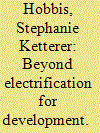

|
|
|
|
|
| Summary/Abstract |
Based on an in-depth examination of the acquisition, use, maintenance and deterioration of solar home systems in a village in Malaita, Solomon Islands, this article challenges the analytical focus of current debates on electrification in Pacific Island countries – why Pacific Island countries have not yet sufficiently electrified to achieve their development goals. Alternatively it examines what is, how, in this case, rural Solomon Islanders have integrated already available electricity into their daily lives. This perspectival shift highlights how rural Solomon Islanders have developed an energy identity that corresponds to their needs, interests and values, rather than those of national and international actors. It re-emphasises the struggles of national and international electrification initiatives in rural environments, linking them to a broader distrust in the motivations of external actors. At the same time, it reveals how, throughout their life cycle, rural solar home systems have become integrated into processes of social reproduction rather than development aspirations. Contrary to dominant debates, rural solar home systems matter most in the opportunities that they provide for reciprocal exchange than for what the electricity enables them to do.
|
|
|
|
|
|
|
|
|
|
|
|
|
|
|
|
| 3 |
ID:
104969


|
|
|
|
|
| Publication |
2011.
|
| Summary/Abstract |
Assessments of the impact of electrification on the quality of life of households in developing countries have increased over the last decade. One aspect that has still received little attention is education and the ability of children to keep up at school. The underlying hypothesis is that electrification enables children to do their homework in the evening and so keep up with their school work. To this first hypothesis we add a second one, concerning the relation between access to electricity and attendance to school according to gender. Although most household tasks are carried out by the mothers, their daughters are also involved, and electrification could have a beneficial effect by making easier for girls to do their homework in the evening and easier for the mothers to help them. We will check the validity of these hypotheses using a case study of 162 children attending school in a small town in northwestern Madagascar.
|
|
|
|
|
|
|
|
|
|
|
|
|
|
|
|
| 4 |
ID:
112328
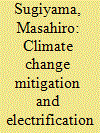

|
|
|
|
|
| Publication |
2012.
|
| Summary/Abstract |
An increasing number of mitigation scenarios with deep cuts in greenhouse gas emissions have focused on expanded use of demand-side electric technologies, including battery electric vehicles, plug-in hybrid vehicles, and heat pumps. Here we review such "electricity scenarios" to explore commonalities and differences. Newer scenarios are produced by various interests, ranging from environmental organizations to industry to an international organization, and represent a variety of carbon-free power generation technologies on the supply side. The reviewed studies reveal that the electrification rate, defined here as the ratio of electricity to final energy demand, rises in baseline scenarios, and that its increase is accelerated under climate policy. The prospect of electrification differs from sector to sector, and is the most robust for the buildings sector. The degree of transport electrification differs among studies because of different treatment and assumptions about technology. Industry does not show an appreciable change in the electrification rate. Relative to a baseline scenario, an increase in the electrification rate often implies an increase in electricity demand but does not guarantee it.
|
|
|
|
|
|
|
|
|
|
|
|
|
|
|
|
| 5 |
ID:
133101
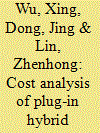

|
|
|
|
|
| Publication |
2014.
|
| Summary/Abstract |
Using spatial, longitudinal travel data of 415 vehicles over 3-18 months in the Seattle metropolitan area, this paper estimates the operating costs of plug-in hybrid electric vehicles (PHEVs) of various electric ranges (10, 20, 30, and 40 miles) for 3, 5, and 10 years of payback period, considering different charging infrastructure deployment levels and gasoline prices. Some key findings were made. (1) PHEVs could help save around 60% or 40% in energy costs, compared with conventional gasoline vehicles (CGVs) or hybrid electric vehicles (HEVs), respectively. However, for motorists whose daily vehicle miles traveled (DVMT) is significant, HEVs may be even a better choice than PHEV40s, particularly in areas that lack a public charging infrastructure. (2) The incremental battery cost of large-battery PHEVs is difficult to justify based on the incremental savings of PHEVs' operating costs unless a subsidy is offered for large-battery PHEVs. (3) When the price of gasoline increases from $4/gallon to $5/gallon, the number of drivers who benefit from a larger battery increases significantly. (4) Although quick chargers can reduce charging time, they contribute little to energy cost savings for PHEVs, as opposed to Level-II chargers.
|
|
|
|
|
|
|
|
|
|
|
|
|
|
|
|
| 6 |
ID:
175017


|
|
|
|
|
| Summary/Abstract |
Measuring energy access in developing countries involves much more than simply recording whether or not households are connected to the grid. Both international organizations and scholars now recognize the importance of reliable electricity supply for achieving positive development outcomes. Yet, measuring reliability is much more difficult than measuring the existence of connections. We propose an economical croudsourcing method for measuring reliability, and compare this method to energy monitor data for 122 households over 12 months. The results suggest that, while far from perfect, crowdsourcing provides a reasonably accurate method for monitoring the reliability of access over time, especially when modeled as a non-linear relationship. We apply these findings to model energy reliability in a broader group of villages across Uttar Pradesh, India, demonstrating the existence of disparities between urban and rural reliability and seasonal fluctuations in reliability. The system laid out in this study can be utilized by government and non-government organizations to quickly and cheaply monitor energy reliability.
|
|
|
|
|
|
|
|
|
|
|
|
|
|
|
|
| 7 |
ID:
183586
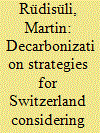

|
|
|
|
|
| Summary/Abstract |
Decarbonizing the energy system by electrification of heat and transport is only effective when using low-carbon electricity sources. As many countries such as Switzerland rely on imported electricity to meet their demand, the greenhouse gas (GHG) content of electricity imports must be correctly accounted for. By assuming an average GHG content for each amount imported, impacts of electricity required in peak periods are underestimated because additional (marginal) demand is primarily met with fossil power plants. This study employs a model to capture marginal GHG contents of imported electricity from a direct and indirect (life-cycle) perspective at an hourly resolution. Implications on GHG are explored for various electricity demand and supply scenarios including electrification of heat and transport, large-scale expansion of renewables, and nuclear phase-out. We find that depending on the scenario, the average GHG intensity of consumed electricity may double, while diurnal and seasonal variations are even larger. Nonetheless, results show substantial GHG mitigation of up to 45% with electrification in case of deploying a diversified electricity generation portfolio including photovoltaics and wind. For optimal GHG mitigation, short-term flexibility as provided by hydropower is necessary to manage electricity surpluses. The main challenge, however, surrounds seasonal energy storage including sector coupling.
|
|
|
|
|
|
|
|
|
|
|
|
|
|
|
|
| 8 |
ID:
191369
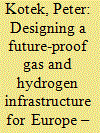

|
|
|
|
|
| Summary/Abstract |
Hydrogen has been at the centre of attention since the EU kicked-off its decarbonization agenda at full speed. Many consider it a silver bullet for the deep decarbonization of technically challenging sectors and industries, but it is also an attractive option for the gas industry to retain and future-proof its well-developed infrastructure networks. The modelling methodology presented in this report systematically tests the feasibility and cost of different pipeline transportation methods – blending, repurposing, and dedicated hydrogen pipelines - under different decarbonization pathways and concludes that blending is not a viable solution and pipeline repurposing can lead to excessive investment outlays in the range of EUR 19–25 bn over the modelled period (2020–2050) for the EU-27.
|
|
|
|
|
|
|
|
|
|
|
|
|
|
|
|
| 9 |
ID:
192764
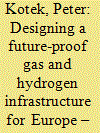

|
|
|
|
|
| Summary/Abstract |
Hydrogen has been at the centre of attention since the EU kicked-off its decarbonization agenda at full speed. Many consider it a silver bullet for the deep decarbonization of technically challenging sectors and industries, but it is also an attractive option for the gas industry to retain and future-proof its well-developed infrastructure networks. The modelling methodology presented in this report systematically tests the feasibility and cost of different pipeline transportation methods – blending, repurposing, and dedicated hydrogen pipelines - under different decarbonization pathways and concludes that blending is not a viable solution and pipeline repurposing can lead to excessive investment outlays in the range of EUR 19–25 bn over the modelled period (2020–2050) for the EU-27.
|
|
|
|
|
|
|
|
|
|
|
|
|
|
|
|
| 10 |
ID:
163531
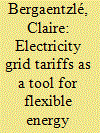

|
|
|
|
|
| Summary/Abstract |
Electricity grid tariffs are a lever for reinforcing the coupling of district heating systems to the electricity system and for activating flexibility from power-to-heat (P2H) technologies and storage capacities. This study assesses three tariffs that permit a flexible use of electric boilers in a representative district heating system in Denmark. A mixed integer programming model is developed to evaluate the impact of each tariff on district heating flexibility quantitatively. The tariffs are then discussed in the light of the regulatory requirements that network tariffs must comply with.
|
|
|
|
|
|
|
|
|
|
|
|
|
|
|
|
| 11 |
ID:
171470
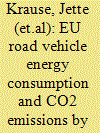

|
|
|
|
|
| Summary/Abstract |
To inform long-term policies on transport decarbonisation, the present paper analyses European road transport CO2 emission reduction options by 2050. The investigation focusses on measures improving tank to wheel vehicle efficiency, but takes into account upstream emissions of electric vehicles. Measures for vehicle efficiency improvement, transport smoothing, and transport reduction, as well as possible 2050 road vehicle fleet compositions have been quantified through expert group discussion and combined with fleet impact modelling to calculate scenario results.
Outcomes show that tank to wheel road transport CO2 emission reductions up to 90% versus 1990 could be reached by 2050 through strong fleet electrification and if all measures achieve their best potential. Under ambitious fleet electrification scenarios, CO2 reduction of more than 60% is reached without measures, but causes substantial additional demand for low-carbon electricity, the availability of which is not covered in this paper. It is likely that policies will be a prerequisite for fleet electrification and efficiency increases of the order of magnitude assumed. Moreover, upstream CO2 emissions of electricity for battery and plug-in hybrid electric vehicles could add up to 40% of tank to wheel emissions, suggesting that complementary policies are needed to avoid shifting transport emissions to other sectors.
|
|
|
|
|
|
|
|
|
|
|
|
|
|
|
|
| 12 |
ID:
119580


|
|
|
| 13 |
ID:
183594
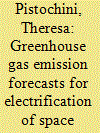

|
|
|
|
|
| Summary/Abstract |
This study aims to inform policymakers about the greenhouse gas emission impacts of heat pump deployment in residential homes. Electric heat pumps eliminate direct burning of fossil fuels in homes but result in indirect emissions due to fossil fuels burned for electricity production. This paper presents the first detailed emission forecasts for operating either a heat pump or gas furnace for residential heating over a 15-year period, starting in year 2022 through 2036, in six regions across the US. The study accounted for long-run marginal emissions from electricity generation, emissions from natural gas combustion in homes, and fugitive methane and refrigerant emissions from leaks. The population weighted US average results show emission reductions for a heat pump over furnace to be 38–53% for carbon dioxide, 53–67% for 20-Year global warming potential (GWP), and 44–60% for 100-Year GWP, with reductions increasing over time. The impact of fugitive emissions from the furnace is significantly higher than that of the heat pump. While more energy efficient construction reduces overall emissions for both heating types, the forecasted percent emission reduction for replacement of a gas furnace with heat pump was not impacted by changes in home construction parameters.
|
|
|
|
|
|
|
|
|
|
|
|
|
|
|
|
| 14 |
ID:
166313
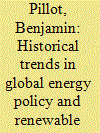

|
|
|
|
|
| Summary/Abstract |
From 1972 and the Meadows report to 1997 and the ratification of the Kyoto Protocol by most of the countries in the world, the global energy policy framework has moved on to considering the concept of sustainable development. Regarding electrification, modern renewable power systems such as solar PV have sprung up in the wake of this major mutation and have typically undergone a significant growth since the beginning of this century. In this paper, we first investigate the historical interactions between energy and society in both global and Sub-Saharan contexts and how renewable power has ended up being considered accordingly. From the need for sustainable development to grid-connected architecture on the one hand; from the lack of human development to rural off-grid electrification on the other. Then, using the case of solar PV, we propose a reading of the issues and challenges renewable power systems are currently facing in Sub-Saharan Africa, by linking those aspects to the previously stated global policy framework, and in particular the historical segmentation of the renewable energy worldwide market between grid-connected and off-grid sectors.
|
|
|
|
|
|
|
|
|
|
|
|
|
|
|
|
| 15 |
ID:
091584


|
|
|
|
|
| Publication |
2009.
|
| Summary/Abstract |
Infrastructure planning for networked infrastructure such as grid electrification (or piped supply of water) has historically been a process of outward network expansion, either by utilities in response to immediate economic opportunity, or in response to a government mandate or subsidy intended to catalyze economic growth. While significant progress has been made in access to grid electricity in Asia, where population densities are greater and rural areas tend to have nucleated settlements, access to grid electricity in Sub-Saharan Africa remains low; a problem generally ascribed to differences in settlement patterns. The discussion, however, has remained qualitative, and hence it has been difficult for planners to understand the differing costs of carrying out grid expansion in one region as opposed to another. This paper describes a methodology to estimate the cost of local-level distribution systems for a least-cost network, and to compute additional information of interest to policymakers, such as the marginal cost of connecting additional households to a grid as a function of the penetration rate. We present several large datasets of household locations developed from satellite imagery, and examine them with our methodology, providing insight into the relationship between settlement pattern and the cost of rural electrification.
|
|
|
|
|
|
|
|
|
|
|
|
|
|
|
|
| 16 |
ID:
186496
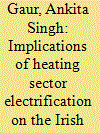

|
|
|
|
|
| Summary/Abstract |
Electrifying the heating sector, which is energy and carbon intensive, and shifting electricity supply to renewable technologies is one of the main policy options being pursued for decarbonisation of the heating sector. Heat pumps are widely adopted for this purpose. However, the impact of this policy on existing electrical systems, both from the perspectives of supply and demand, is understudied in the literature. This paper examines the system-wide impacts of integrating high quantities of heat pumps, in line with government targets, in Ireland. We provide a broad discussion of the ramifications of heating sector electrification in terms of system costs and expansion planning under renewable energy targets. Results reveal significant changes in generation and increases in associated costs with increasing levels of electrification. On the flip side, the heating sector electrification leads to more efficient utilisation of renewable energy and the transmission network. We also explore alternative policy pathways to minimize impacts on the system. These include determining optimal locations for heat pump integration and a technology-neutral emission reduction target. Optimal distribution of heat pumps has a low impact on system metrics whereas pursuing an emission reduction target makes a large impact on system costs.
|
|
|
|
|
|
|
|
|
|
|
|
|
|
|
|
| 17 |
ID:
176661
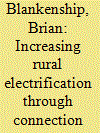

|
|
|
|
|
| Summary/Abstract |
To reach the United Nations Sustainable Development Goal of universal household electrification by 2030, developing countries are spending billions of dollars to expand access. India, for example, recently undertook an audacious expansion plan which aimed to electrify every household by December 2018. However, there is little academic study of strategies to increase electrification rates. We argue that significant transaction costs inhibit household applications for connections. As evidence, we report the results of a randomized controlled trial (in 200 communities and 2000 households) in the Indian state of Uttar Pradesh, with a treatment consisting of an informational campaign about the costs and procedure of applying. We found that households exposed to the campaign were three times as likely to apply for a connection. Yet actual connection rates remained unchanged. The results suggest that transaction costs are an important barrier to electrification, but limited capacity and incentive to expand connections are equally important.
|
|
|
|
|
|
|
|
|
|
|
|
|
|
|
|
| 18 |
ID:
137708
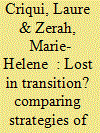

|
|
|
|
|
| Summary/Abstract |
This paper examines the notion of energy transition when implemented by private utilities. In 2000, the Delhi government privatized electricity distribution to three private distribution companies. Most research was concerned with the impact of privatization on energy reliability, tariff settings and regulation issues. This paper looks at two under-researched themes: the expansion of services to poorer neighborhoods and the rollout of clean energy policies. This focus allows to unpack the materiality of socio-technical systems, to analyze how energy infrastructures are being technically deployed on the ground and to identify which social approach is used. To detail the specific practices of each company provides a more nuanced and accurate understanding of the reform. In-depth analysis of the three private utilities show that they interpret the reform mandate differently: they use a varied range of technical tools; they respond differently to social concerns in poorer neighborhoods; and they have distinctive internal management choices and corporate cultures. All these four factors can strengthen or undermine the transition towards increased access and clean energy.
|
|
|
|
|
|
|
|
|
|
|
|
|
|
|
|
| 19 |
ID:
122738


|
|
|
|
|
| Publication |
2013.
|
| Summary/Abstract |
Debates on the nexus between energy and development emphasise that access to modern energy carriers such as electricity improve development outcomes. This paper discusses the impacts of electrification on educational outcomes, gender and power relations, income generation, feelings of inclusion and exclusion and health in the village of Tsilitwa in the rural Eastern Cape, South Africa. It is based on an ethnographic grounded theory study conducted in 2009. The paper shows that the impacts of electricity may not match the benefits cited in the literature, and are not experienced in the same way by everyone in the community. The study uncovers the weakness of ignoring individual and group agency, and the complexity of social settings when advocating interventions to improve quality of life. The paper recommends that researchers and policymakers consider using ethnographic methods to complement other methods and reveal context and its implications on the energy-development nexus that other methods may not capture.
|
|
|
|
|
|
|
|
|
|
|
|
|
|
|
|
| 20 |
ID:
137714
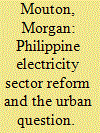

|
|
|
|
|
| Summary/Abstract |
In the early 2000s, the Philippine government reformed its electricity sector following neoliberal principles: unbundling of the power industry, privatisation of assets and commodification of electricity. This paper shows that the reform was primarily driven by the need to secure electricity supply and cut down tariffs. These national objectives ousted other issues, and notably those that find their expression at the urban level, among which the question of access to electricity in Metro Manila's urban poor communities. The central state withdrew its attention from the issue of electrification, and local actors had to react as they were confronted to social tensions and practices of pilferage. As a consequence, city governments and local administrations are getting involved in this issue, which opens the way to participation of civil society. This paper shows how the “rolling back” of the central state led to new partnerships and arrangements between the distribution utility, local governments and community organisations. This movement points to an urbanisation of energy issues, which could bring positive results for end-users provided that it is accompanied by a clearer regulatory framework.
|
|
|
|
|
|
|
|
|
|
|
|
|
|
|
|
|
|
|
|
|